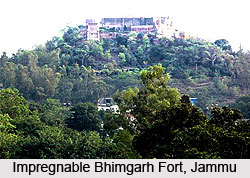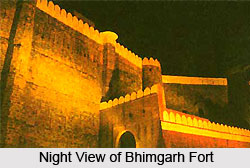 Bhimgarh Fort is also referred to as the `Reasi Fort` and is located close to Reasi town which is existent at a distance of nearly 64 kms away from the north-western part of Jammu, on the summit of a hillock which measures 150 metres in height. The fort is present in Jammu and Kashmir was originally erected by one of the descendants of Maharaj Rishipal Rana, with the aide of clay and later it was remodelled employing stone. Members of the royal families often sought shelter in the Bhimgarh Fort during times of emergencies and the main entrance of this fort is composed of Rajasthani carving of Baluka stones. The front wall of this fort is about 50 metres in length and measures one metre in width, engraved with a statue of Lord Hanuman and Goddess Mahakali. There exists a treasury, temple, various rooms of different sizes and a pond inside the fort premises. Presently, Bhimgarh Fort is damaged by absence of proper preservation measures and earthquakes.
Bhimgarh Fort is also referred to as the `Reasi Fort` and is located close to Reasi town which is existent at a distance of nearly 64 kms away from the north-western part of Jammu, on the summit of a hillock which measures 150 metres in height. The fort is present in Jammu and Kashmir was originally erected by one of the descendants of Maharaj Rishipal Rana, with the aide of clay and later it was remodelled employing stone. Members of the royal families often sought shelter in the Bhimgarh Fort during times of emergencies and the main entrance of this fort is composed of Rajasthani carving of Baluka stones. The front wall of this fort is about 50 metres in length and measures one metre in width, engraved with a statue of Lord Hanuman and Goddess Mahakali. There exists a treasury, temple, various rooms of different sizes and a pond inside the fort premises. Presently, Bhimgarh Fort is damaged by absence of proper preservation measures and earthquakes.
History of Bhimgarh Fort
Gulab Singh of Jammu and Kashmir started renovation task of the Bhimgarh Fort during the year 1817 which lasted till 1841.
 The fort was constructed in a manner which prevented the invasions of enemies, as it was strengthened by a strong stone wall. General Zorawar Singh is believed to have supervised the erection of this massive fort, who had commenced his career as a soldier, working under Gulab Singh. In the year 1989, the fort was transferred to the Jammu and Kashmir State Archaeology Department upon the orders of the State Government of India and the Vaishno Devi Sthapna Board was entrusted the responsibility of renovating the fort during the year 1990. Even the nearby areas of the fort were remodified, and enriched with beautiful gardens and pathways. Finally, the fort was permitted to be accessed by the common masses.
The fort was constructed in a manner which prevented the invasions of enemies, as it was strengthened by a strong stone wall. General Zorawar Singh is believed to have supervised the erection of this massive fort, who had commenced his career as a soldier, working under Gulab Singh. In the year 1989, the fort was transferred to the Jammu and Kashmir State Archaeology Department upon the orders of the State Government of India and the Vaishno Devi Sthapna Board was entrusted the responsibility of renovating the fort during the year 1990. Even the nearby areas of the fort were remodified, and enriched with beautiful gardens and pathways. Finally, the fort was permitted to be accessed by the common masses.
Architecture of Bhimgarh Fort
Though Bhimgarh Fort is small, it is located at a great height, on the mountains, which makes it a prominent attraction as it can be easily viewed from a great distance. Contemporary architectural characteristics have been observed in the Bhimgarh Fort along with styles of `Dogra` made in the form of a temple. An irregular plan has been following while establishing the fort mainly due to the rocky natural terrain of the region. The fort is well protected by bastions and a sturdy fortification wall. Sandstone masonry in lime mortar has been utilized to create the double fortification of the Bhimgarh Fort. There are about five large bastions inside the fort. An iron ladder in the fort is employed by the visitors of this fort who look forward to accessing the fort and it is existent near the gate of the garden near the outer road of Reasi. An open courtyard is present inside the premises of Bhimgarh Fort and it is guarded by a residential plot.




